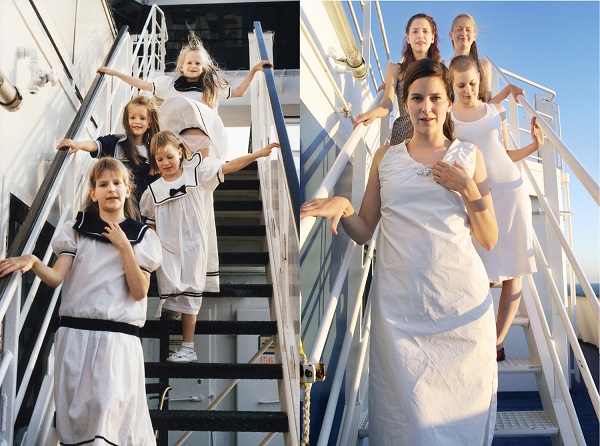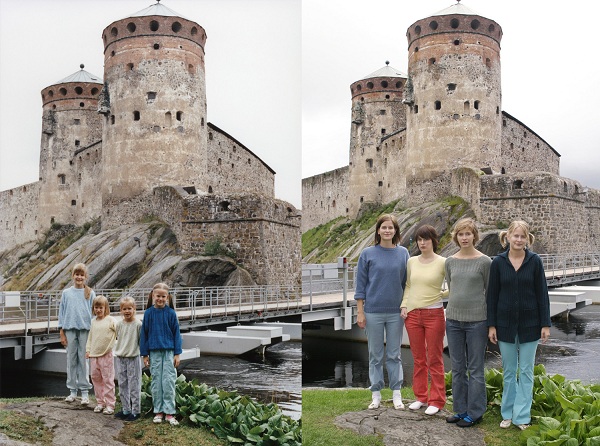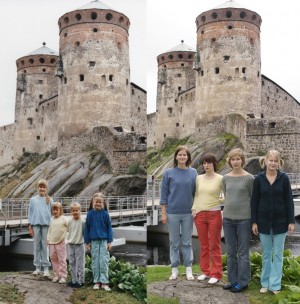Artist of the Week 9/12-9/18: Wilma Hurskainen Recreates Her Childhood Photos
Have you ever wished you could go back in time to a moment that was forever encapsulated in a worn-out childhood photograph with its ripped, brown edges – a moment of subliminal innocence and delight that held no superfluous subtext or endless adult histrionics? While many of us might have had encountered more than our share of unpleasantries during our youth – things we’d like to hide away in the back of the mazes of our minds, much less revisit – there were also those fleeting seconds of saccharine sweetness that left a dreamy aftertaste of promise and wonder. And it is flashes like those that Finnish photographer Wilma Hurskainen captured in her familial series Growth.
Devoted entirely to the whimsy of the artist’s early years, Growth is a recreation of photos of Hurskainen and her three sisters from when they were between the ages of three to 11. The images are restructured with inconceivable accuracy starting with their location and additional family members, right down to the sisters’ clothing, facial expressions and poses. Hoping to expose something that had been hidden in a still frame, Hurskainen, as she herself writes on her Web site, created “a dialogue between the past and the present moment.” But reconstructing the photos and gathering the immediate family members back at their childhood home in Helsinki, Finland was anything but easy due to everyone’s separate plans and lives. In fact, for a good portion of the time, the project was one of the only things that kept bringing them back together in one place due to everyone’s hectic schedule – an instance that Hurskainen felt was unfortunate.
“By the time we were photographing the series we lived in different cities and went to student exchanges abroad, etc., so we hardly ever met and it was very difficult to find the dates for the photo shoots,” Hurskainen said. “At some point, I felt like we only met for this purpose, which is not good of course. And after the work was finished, it still took me a few years to first find a publisher for the book and then get it done. But actually, I don´t mind working quite slowly, even these days; I don´t want to rush or force things.”
Visiting places from more than a decade ago, the sisters embarked on a journey of laughter, discovery, nostalgia, and a bit of irritation and grief. Yet in the midst of all these emotions and unveilings, they came to a mutual understanding and realization that the passage of time is not something to be afraid of, but something that should be embraced. Though the series originally ended in 2006 with the publishing of the book, Hurskainen continues to take photos of her sisters in the series, all while in the midst of working on her new projects, inclusive of the latest series entitled The Woman Who Married a Horse.
“I have recently published a book called Heiress by German Kerber Verlag. It includes photographs and little texts and still deals with childhood, memory, etc., and I´m still photographing my sisters in the series! I’m also exhibiting new works from a recent series called The Woman Who Married a Horse — again girls/women who share their twisted reality with horses this time,” she said.
Taking a small break from her own demanding schedule, Hurskainen sheds new light on Growth and the unpredictability of life.
GALO: You write on your site that: “By repeating a distant moment something weird is revealed about us as objects of the photograph in the first pictures: the way we play our artificial roles for the photograph. We might not be more than five-years-old, but we already know exactly how to be in/for a photograph.” What exactly do you mean by artificial roles? Are images, in your opinion, not a capture of the moment in time, but rather a fake moment that is somehow created by the people and the environment? Are we actors in that moment, playing a distinct role?
Wilma Hurskainen: I think we often tend to think that a photograph could “capture our true self” — and then we can, for example, be disappointed at how we look in a photograph: “That isn´t me.” But, like Roland Barthes [a French literary critic and philosopher] has put it: “In front of the lens, I am at the same time: the one I think I am, the one I want others to think I am, the one the photographer thinks I am, and the one he makes use of to exhibit his art.” Even in our childhood images, we are creations of our mother (she has chosen our clothes) and our father (he has chosen the way we´re shown: still and orderly). So, in my opinion, the posing is not really about being “fake,” “artificial” or “natural” — it´s a more complex thing than this.

“On the Deck” is a photo from the series “Growth” by Wilma Hurskainen. Photo Credit: Wilma Hurskainen.
GALO: Perhaps a straightforward question, but probably one that is going through most readers’ minds — which girl and woman in the photos is you?
WH: I´m the oldest one; one of my sisters is two years younger than me and the twins are four years younger than me. So, let´s take for example the image of the Castle Olavinlinna [in Savonlinna, Finland]: I´m the oldest/tallest, on the left in the row. And then, of course, in the latter image, we´re in the same order so I´m again on the left. Or in the image On the Deck, I´m the one in front! It´s funny how I´m a lot taller than my little sisters in a lot of the images…

“Castle Olavinlinna” from the “Growth” series by Wilma Hurskainen. Photo Credit: Wilma Hurskainen.
GALO: Many of the images are taken outside such as on the steps of a boat, outside of a castle, atop an observatory on a mountaintop, and by a sculpture of what appears to be a lion. What were some of the locations that you revisited to take these pictures and others in the series?
WH: Most of the images were photographed at my parents´ house in Vantaa, in Helsinki. We [also] went on several trips to Eastern Finland (where my father is originally from) [and took photos] in cities like Kuopio and Savonlinna. And then we took many boat trips to Stockholm in Sweden.
(Article continued on next page)

